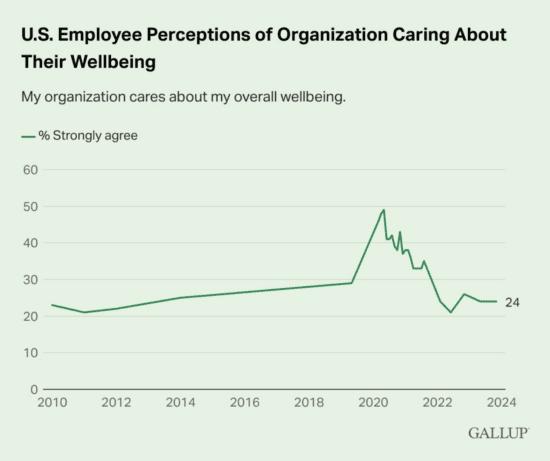Overcoming obstacles and driving performance through empathy
Over the past few years, it seems that the subject of empathy has blossomed into a mainstream consideration. One of the reasons for this heightened awareness around empathy was presumably stimulated by a lack of perceived empathy, with many bemoaning the state of civility in society, spiking mental health issues and continued disengagement of employees. Even before the pandemic, empathy was becoming a hot topic. Then, during the lockdowns and an obligation of remote work, all of sudden empathic leadership almost seemed to be in vogue. I’ve counted no less than 300 new books with the word “empathy” in the title or subtitle. Even Tony Robbins wrote about “Empathetic Leadership” in 2021. But, by many accounts, for all the talk (and writing), it seems that empathy’s back on the decline. A recent Gallup survey about the employees’ perception of their employer’s sense of caring about their well-bring (which I’d say is a decent proxy for empathy) shows that things have come back down to pre-pandemic levels.

Going back to a study, published in 2010, entitled, “Empathy in Leadership: Appropriate or Misplaced? An Empirical Study on a Topic that is Asking for Attention,” and authored by Svetlana Holt and Joan Marques out of Woodbury University, Burbank CA, it demonstrated that business students and business leaders appear to be naturally less empathic (than other types of students or leaders). In research presented in the Journal of Education for Business*, also in 2010, the authors asserted that “business students are more focused on self-interest than students in other fields.” In their study, they found that business students (as opposed to other types of students) cheat more, are less cooperative, and more likely to conceal instructors’ mistakes in bargaining games, which they equate with less ethical and narcissistic behaviour.
Impediments to empathy… in society
If many are talking about and clamouring for a need for more empathy, it does indeed seem to be lacking in many circles. On the one hand, you have those who have a heightened sense of self, greater egotism and narcissism and a sense of entitlement. Research confirms that people in privileged positions (i.e. wealthy individuals) tend to be empathically challenged.** On the other hand, the environment is generally hostile and doesn’t seem to reward those who listen, who show empathy and are prosocial. It’s more about those who scream and grab attention… which they (including you and me?) do in many different ways. I, for sure, have times when I’m better able to be empathic; for example, where the context is easier, where time allows and my mind is tranquil. When times get hard, it’s natural that people will tend to resort to saving their own skin rather than going out of their way to help others. In this article, I will address the notion of creating a more empathic culture in your organisation, looking at the key obstacles that can make it hard to be empathic and explore some ways that you can ‘implement’ empathy and measure success.
Why create an empathic culture?
So, let’s start with the why (not the Simon Sinek why, yet!). Numerous studies, thousands of articles and hundreds of books describe the perceived benefits of culture in leadership. The list of reasons why empathy helps business performance is indeed long. Here’s a non-comprehensive list of reasons why you, as a business leader, might want to create an empathic culture in your organisation:
- increase customer satisfaction
- enhance employee engagement
- build an ethical Artificial Intelligence
- strengthen your innovation pipeline
- build trust into your partnerships
- create more effective marketing
- hire and retain the best talent
- win tough negotiations
- …
And the list could go on. Leaders and employees alike seem to believe that empathy improves engagement and retention, design thinking and the innovation process, and drives bottom line performance. It can help in many situations, yet is it remarkably 0difficult to bring change in your culture. As ever with culture, there is what is written on company walls or in annual reports. Then there is what people perceive and think. Bear in mind that I don’t subscribe to having empathy with everyone, all the time, in every situation. However, if any of the above are of interest to you in your business, please read on!
Why doesn’t empathy happen in business?

Via Unsplash
Outside of the issue of the empathically challenged wealthy leaders, there are multiple factors that lead to empathy not being applied at work. For starters, as we explored during the “Empathy that counts” immersive experience that I co-ran with Lena Rantsevich (founder of Reputy.io), we have a muddled understanding of what empathy actually is. For the record, I define empathy as understanding the feelings, thoughts and experience of the other. I divide it into two components that can be discrete: cognitive empathy (able to understand, even verbalise someone else’s situation) and affective empathy (feeling the other person’s feelings). Some empathy experts maintain that there are many other forms of empathy or that there can be no separation of cognitive and affective in empathy. I am deeply convinced that cognitive empathy can exist as a standalone, AND that it can be learned and applied in business with greater ease and effectiveness than affective empathy. In any event, getting a shared understanding of what it is and how it can be applied is a great starting point for leaders to explore in an executive committee setting. A difficult thing for business leaders to get their head around is how to evaluate and measure a soft skill such as empathy. For sure, there’s no easy answer. My approach is to find and define observable behaviours that allow everyone to understand what is meant by an empathic culture in your specific organisation. One thing to bear in mind is that, with empathy, there is an emitter and a receiver. To merely rely on the receiver’s perception of empathy would limit the scope that empathy could have in business. For example, take empathy in the design process. When a new product (or service) is created in the laboratory, any empathy invested in the development of the product will not be discretely felt by the end customer. Or, in the case of taking a tough decision to let go of a talented individual who doesn’t fit in to your team, you might be applying organisational empathy that is entirely abstract to the rest of the team.
There are two mitigating factors that cut down on our empathic tendencies in a work environment. These are stress and a lack of time. The same is true in professional sports, especially as it comes to stress, as I discussed with Peter Sear, author of “Empathic Leadership, Lessons from elite sport.” But, in work, the stress of performance — including dealing with office politics, oversized egos and miscommunications — leads to a more base behaviour, one where the end justifies the means. Too much stress is bound to overwhelm our higher order of thinking. The second challenge in business is to carve out the time to listen to and observe those around you. If you want to understand bettter someone else’s thoughts and feelings, you need to dedicate some energy and time to lean into their situation. Unless you’re an empath (a naturally — even overly — empathic person), empathy takes intentionality. It requires being present with the other person. To be present when stress is high and time is of short supply is a tall order. Thus, it requires that leaders are purposeful about being more empathic. In any event, if your desire is to create a more empathic culture, the leadership team must lead by example.
As I describe in Heartificial Empathy, there are certain jobs and industries where empathy is hard if not impossible to implement. De facto, empathy is in short supply in the more hardcore financial services companies (i.e. investment banking, private equity…). So, it may not be entirely the most important solution for your context. To reiterate, I don’t subscribe to a tyranny of empathy. Notably, if you as a leader sense that you don’t have the energy or presence of mind to listen without judgment, practising self-empathy may mean you are not in shape enough to give empathy to another. That said, on balance, I find that the objective of having a more empathic culture than you currently have is bound to bring benefits.
Bringing empathy into your culture

Via Unsplash
The first port of call is to gauge where you sit presently as a culture. To what extent do you have empathic culture? Again, as mentioned above, merely defining what that means and looks like, can be a first element of progress. Secondly, it is incumbent on your executive team to understand why you wish to up your empathic game. If you’re the Human Resources manager, notwithstanding the fact that HR is typically the empathic centre of a company, it would be important to present your wish for a more empathic culture as part of a strategic initiative. Folding in empathy into a project or axe of work that’s of strategic importance will help to garner the attention and resources necessary. Third, your senior team needs to develop and communicate what an empathic culture looks like for you, specifically. Integrating middle level managers into the definition and development of an empathic culture will of course be vital. To avoid this being an eye-rolling exercise, it pays to have a certain pragmatism and realism to your objectives. Soft skills don’t get learned over night. While hiring new recruits for their empathic level might be a good idea, it’s important that you start with yourself and your existing internal culture. There’s no point in bringing in an empathic person if the current culture is non-empathic. Depending on your level of conviction and the resources you’re prepared to spend to create a more empathic culture, you’ll potentially want to bring in someone from the outside to help structure and animate the way empathy is brought into the organisation.
Whatever happens, changing your culture is not just a long process, it’ll be ongoing and evolving. Like digital transformation, diversity or sustainable development, these ‘initiatives’ must be embedded into the operations and throughout the company. I shy away from using empathy as a standout company value. I believe it’s more realistic to bring empathy into a strategic project than to declare it as a specific soft skill to develop. And, in so doing, you can appreciate just how effective its presence in the process has helped (or not).
Implementing and measuring empathy

via Unsplash
As for implementing empathy, I propose that each leadership team discuss its own style of empathy, depending on the company’s context and ambitions. For example, will you be willing to ask whether your employees feel that leadership is empathic? Or would you rather cite a behaviour that’s a proxy for empathy in your context (as described above), where empathy is described as specific action or feeling? In this case, you might ask in an employee survey:
- To what extent do you feel that your voice is heard in the organisation?
- To what extent does your leadership care for your well-being?
- To what extent does leadership embrace a diversity of thought?
Ideally, empathy is looked on as a soft skill that runs inside-out, where it exists within the fabric of the company culture and is re-presented outward toward external parties (be their third-party suppliers, distributors or customers). It’s crucial to have congruency and consistency between the internal culture and how you expect to interact with your customers. This is the classic error made by companies that focus merely on customer centricity without being employee first. After all, it is the employee who will be delivering customer success. A 2019 study by EY looked at the characteristics that are associated with empathic leadership. These bear detailing:
- Open and transparent (identified by 41% of respondents)
- Fair (37%)
- Follows through on action (37%)
- Encourages others to share their opinions (36%)
- Trusted to handle difficult conversations (34%)
As such, these types of qualifications help to figure out how you might measure empathy. I have long used three qualities to define my version of empathic leadership: fair, firm and calm. But it’s not enough to write down the three words. Each deserves to be described with observable actions or traits. Only in this way, can you hold one another accountable.
What about you? What are the ways that you look at, implement and/or measure empathy?
*Brown, T., Sautter, J., Littvay, L., Sautter, A., & Bearnes, B. (2010). Ethics and personality: Empathy and narcissism as moderators of ethical decision making in business students. Journal of Education for Business, 85(4), 203–208.
**For more information, read this article, entitled, “Wealth hurts your capacity for empathy.” Or see this TED Talk by UC Berkeley professor, Paul Piff — it’s going to give you an awkward giggle.











